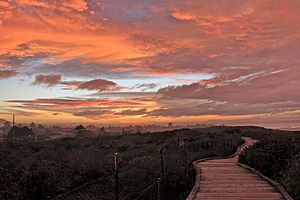Elfin Forest Natural Area facts for kids


The Elfin Forest Natural Area is a special nature preserve in central California. It protects a unique group of plants. This forest is found in Los Osos-Baywood Park, in San Luis Obispo County. It sits on old sand dunes, about 150 feet (46 meters) above Morro Bay.
Contents
What is the Elfin Forest?
The Elfin Forest Natural Area covers 90 acres (about 36 hectares). This land was bought by a group called Small Wilderness Area Preservation (SWAP) starting in 1988. Now, it belongs to San Luis Obispo County Parks and California State Parks. SWAP still helps take care of the forest today. The nature preserve opened to the public in 1994.
Why are the trees so small?
The forest gets its name from its small trees. The main trees here are Coast live oaks (Quercus agrifolia). They look like a "pygmy forest" because they are naturally small. This area has tough conditions like poor soil, salty air, and strong winds. These conditions have stopped the trees from growing tall.
Even though they are small, some of these trees are very old. The largest ones are between 200 and 400 years old! They can be 20 feet (6 meters) tall in sheltered spots. But near the highest ridge, they might only be 4 feet (1.2 meters) tall.
Other small native plants also grow here. They have adapted to the harsh environment. One special plant is the Morro manzanita (Arctostaphylos morroensis). It is only found in this local area.
What kinds of habitats are in the Elfin Forest?
The Elfin Forest is home to many different habitats. These are all part of the California coastal sage and chaparral ecoregion. They include:
- Coastal sage scrub: A type of shrubland near the coast.
- Coastal brackish marsh: A wetland with a mix of fresh and salty water.
- Riparian woodland fringe: Trees and plants growing along a stream or river edge.
- Pygmy California oak woodland: The small oak forest itself.
- Maritime chaparral: Dense shrubs found near the ocean.
- Coastal dune scrub: Plants that grow on sand dunes by the sea.
- Oak and manzanita complex: Areas where oaks and manzanita shrubs grow together.
The Elfin Forest is full of life! It supports over 200 types of plants. You can also find 51 kinds of lichens here. More than 110 types of birds live in or visit the forest. There are also 22 kinds of mammals and 13 types of reptiles and amphibians.
How can you visit the Elfin Forest?
A boardwalk loop helps visitors explore the forest. It is almost 1 mile (1.6 kilometers) long. This boardwalk was built in 1999 to protect the sensitive plants and animals. It makes the forest easy to visit for everyone, including people using wheelchairs. Along the boardwalk, there are viewpoints. From these spots, you can see amazing views of Morro Bay and its sand dunes. You can also watch the many different birds in the estuary.
Who lived here before?
Long ago, before Europeans arrived, the Chumash Native Americans lived in this area. They had an important settlement called Los Osos Back Bay. It was on a stable sand dune just east of the Elfin Forest. There is still a long midden (an ancient trash pile) from the Chumash people within the dwarf forest.



